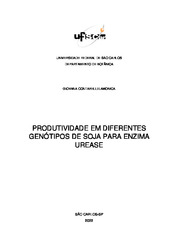| dc.contributor.author | Lamonica, Giovana Contarelli | |
| dc.date.accessioned | 2022-06-01T12:37:45Z | |
| dc.date.available | 2022-06-01T12:37:45Z | |
| dc.date.issued | 2022-04-28 | |
| dc.identifier.citation | LAMONICA, Giovana Contarelli. Produtividade em diferentes genótipos de soja para enzima urease. 2022. Trabalho de Conclusão de Curso (Graduação em Ciências Biológicas) – Universidade Federal de São Carlos, São Carlos, 2022. Disponível em: https://repositorio.ufscar.br/handle/ufscar/16223. | * |
| dc.identifier.uri | https://repositorio.ufscar.br/handle/ufscar/16223 | |
| dc.description.abstract | Plants need nitrogen at all stages of development, which is considered an essential nutrient. Nitrogen can be absorbed from the soil, mainly in the form of inorganic compounds, nitrate, and ammonia. However, urea is an organic nitrogenous compound that plants can also absorb, being hydrolyzed into ammonia and carbon dioxide by the enzyme urease. In soybeans, two main types of urease are found, the ubiquitous urease, present in all plant tissues, and the embryo-specific urease, present in grains and in developing embryos. The objective of this work was to investigate possible changes in the growth and yield of urease mutant soybean plants, as well as to analyze the levels of some nitrogen compounds in the leaves. For this, mutant soybean plants of the following genotypes were cultivated: eu1-a, eu3-a, eu4-a, eu1-a/eu4-c, and Williams 82. After reaching the stage of seed and pod formation, the plants were collected and biometric and biochemical analyzes were performed. Regarding the growth parameters, some differences were observed between the genotypes, mainly between eu4-a concerning the others. In the biochemical analyses, only the nitrate content differed between the mutants. In general, we can conclude that there are differences in the growth of mutant and control genotypes and, at first, the Williams 82 control seems to be the most productive. However, we suggest that more studies be done to evaluate the productivity of the mutants. | eng |
| dc.description.sponsorship | Não recebi financiamento | por |
| dc.language.iso | por | por |
| dc.publisher | Universidade Federal de São Carlos | por |
| dc.rights | Attribution-NonCommercial-NoDerivs 3.0 Brazil | * |
| dc.rights.uri | http://creativecommons.org/licenses/by-nc-nd/3.0/br/ | * |
| dc.subject | Urease | por |
| dc.subject | Ureia | por |
| dc.subject | Nitrato | por |
| dc.subject | Proteinas | por |
| dc.subject | Urease | eng |
| dc.subject | Urea | eng |
| dc.subject | Nitrogen | eng |
| dc.subject | Protein | eng |
| dc.subject | Nitrate | eng |
| dc.title | Produtividade em diferentes genótipos de soja para enzima urease | por |
| dc.title.alternative | Productivity in different soybean genotypes for urease enzyme | eng |
| dc.type | TCC | por |
| dc.contributor.advisor1 | Souza, Sarah Caroline Ribeiro de | |
| dc.contributor.advisor1Lattes | http://lattes.cnpq.br/5432408406468248 | por |
| dc.contributor.advisor-co1 | Lombardi, Ana Teresa | |
| dc.contributor.advisor-co1Lattes | http://lattes.cnpq.br/6737850858443813 | por |
| dc.description.resumo | As plantas necessitam de nitrogênio em todas as fases do desenvolvimento, sendo que este é considerado um nutriente essencial. O nitrogênio pode ser absorvido do solo, principalmente na forma de compostos inorgânicos, nitrato e amônia. Contudo, a ureia é um composto nitrogenado orgânico que também pode ser absorvido pelas plantas, sendo hidrolisado em amônia e gás carbônico pela enzima urease. Em soja, são encontrados dois tipos principais de urease, a urease ubíqua, presente em todos os tecidos vegetais e a urease embrio-específica, presente nos grãos e em embriões em desenvolvimento. O objetivo deste trabalho foi investigar possíveis alterações no crescimento e no rendimento de plantas de soja mutantes para a urease, assim como analisar os níveis de alguns compostos nitrogenados nas folhas. Para tal, foram cultivadas plantas de soja mutantes dos seguintes genótipos: eu1-a, eu3-a, eu4-a, eu1-a/eu4-c e Williams 82. Após atingirem o estágio de formação das sementes e vagens, as plantas foram coletadas e foram feitas análises biométricas e bioquímicas. Com relação aos parâmetros de crescimento, foram observadas algumas diferenças entre os genótipos, principalmente entre o eu4-a em relação aos demais. Nas análises bioquímicas apenas o conteúdo de nitrato diferiu entre os mutantes. De maneira geral, podemos concluir que existem diferenças no crescimento dos genótipos mutantes e controle e, a princípio, o controle Willians 82 parece ser o mais produtivo. No entanto, sugerimos que mais estudos sejam feitos para avaliar a produtividade dos mutantes. | por |
| dc.publisher.initials | UFSCar | por |
| dc.subject.cnpq | CIENCIAS BIOLOGICAS::BOTANICA::FISIOLOGIA VEGETAL | por |
| dc.publisher.address | Câmpus São Carlos | por |
| dc.contributor.authorlattes | http://lattes.cnpq.br/1341455368015516 | por |
| dc.publisher.course | Ciências Biológicas - CB | por |

